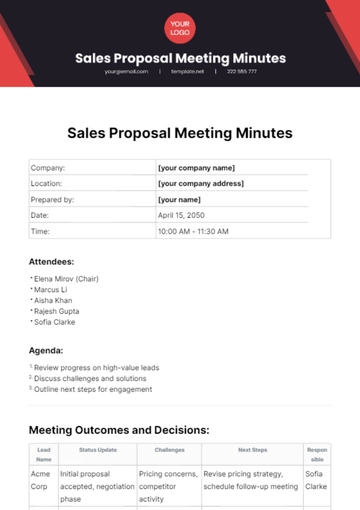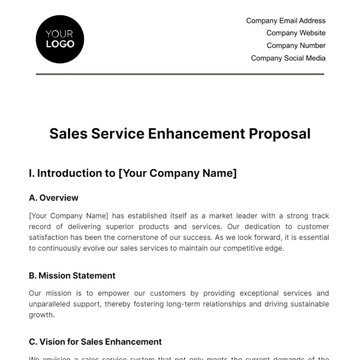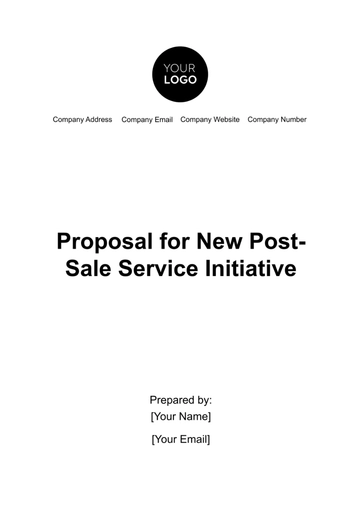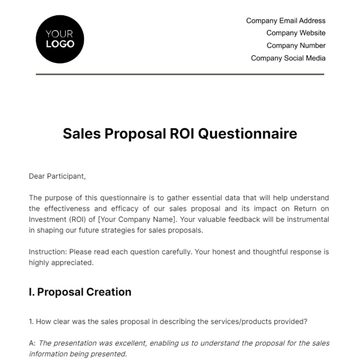Free Sales Target Market Proposal Analysis

I. Executive Summary
In this Sales Target Market Proposal Analysis, we explore a strategic opportunity to expand our market presence by targeting a specific segment. Our research indicates a growing demand within this segment, driven by shifting consumer preferences and emerging trends. By entering this market, we aim to capitalize on this momentum and drive revenue growth.
Through a comprehensive analysis, we define the target market, assess competitors, and develop a robust sales and marketing strategy. This proposal outlines the key findings and recommendations, providing a clear roadmap for successful market entry. With the right execution, we anticipate substantial market share gains and increased profitability in this promising segment.
II. Introduction
In this document, we delve into a pivotal opportunity—entering a specific market segment. Through exhaustive research and analysis, we aim to harness the potential for substantial growth and competitive advantage. Our objective is to align sales and marketing strategies with this market's demands to secure a profitable share. The following sections will unveil essential insights and actionable recommendations for success.
III. Market Overview
In the broader automotive industry, we find a dynamic and ever-evolving environment. Market trends indicate consistent growth, driven by changing consumer preferences and emerging technologies. The automotive industry, of which our target segment, electric vehicles (EVs), is a part, has experienced robust expansion, with a 15% increase in global EV sales over the past five years.
Key trends shaping this market include the rapid adoption of electric vehicles, which is driven by environmental concerns and government incentives. Additionally, the integration of autonomous driving technology and the growth of ride-sharing platforms are transforming the way consumers approach transportation. Government regulations, such as stricter emission standards and subsidies for EVs, are exerting a growing influence on the industry.
In terms of competition, we observe a mix of established automakers like Tesla, Nissan, and General Motors, along with innovative startups like Rivian and Lucid Motors. Major competitors have made significant investments in EV technology, with Tesla leading the market in terms of sales and innovation. Market concentration is currently skewed towards a few major players, but there is ample room for newcomers to carve out a niche.
As we explore our target segment within this dynamic market, it's essential to leverage these insights to devise a market entry strategy that capitalizes on growth opportunities and mitigates potential risks.
IV. Target Market Definition
Our target market is a well-defined segment within the broader automotive industry—specifically, urban commuters and environmentally-conscious consumers seeking affordable, eco-friendly transportation solutions. This segment primarily consists of individuals aged 25 to 45 living in metropolitan areas with a daily commute, covering an average distance of 20 to 50 miles.
Demographically, our target audience is diverse, comprising both professionals and students, with a mix of income levels. Psychographically, they share a common concern for the environment and a desire to reduce their carbon footprint. They value convenience, cost-efficiency, and the latest technology.
Geographically, our initial focus will be on major metropolitan areas in North America, such as New York, Los Angeles, and Toronto, where the demand for eco-friendly transportation alternatives is substantial. Our research indicates that this market segment represents approximately 20% of the total urban commuting population in these cities.
Understanding these demographic, psychographic, and geographic characteristics allows us to tailor our product offerings and marketing strategies to resonate with this target audience effectively. Our aim is to position our electric vehicle models as the ideal solution for urban commuters seeking sustainable and cost-effective transportation choices.
V. Competitive Analysis
Our competitive analysis reveals a dynamic landscape within the electric vehicle (EV) market, where established players and innovative startups vie for market share. Key competitors include industry giants such as Tesla, Nissan, and General Motors, alongside emerging companies like Rivian and Lucid Motors. Each competitor brings its unique strengths and weaknesses to the table.
Competitor | Strengths | Weaknesses |
Tesla | Cutting-edge technology | Production capacity challenges |
Robust charging network | Quality control issues | |
Strong brand image | ||
Nissan | Experience in EV manufacturing | Limited range |
Affordability | Lagging in autonomous driving capabilities | |
General Motors | Nissan Leaf is a best-seller | Traditional image |
Commitment to all-electric future | ||
Diverse EV lineup | ||
Strong resources and distribution network | ||
Rivian | Innovation and strategic partnerships | Scaling up production |
Rugged electric trucks | Limited market presence | |
Lucid Motors | Luxury EVs and advanced technology | Building brand recognition |
Premium market appeal | Developing a robust charging infrastructure |
VI. SWOT Analysis
This analysis provides a strategic overview of our organization's internal strengths and weaknesses, as well as external opportunities and threats. It serves as a valuable tool for informed decision-making and a deeper understanding of our strategic position in the market.
Strengths | Weaknesses |
|
|
Opportunities | Threats |
|
|
VII. Market Research
Through rigorous primary and secondary research methods, we've amassed comprehensive data on our target audience's preferences, needs, and buying habits. Our findings illuminate a rising demand for eco-friendly transportation solutions, especially among urban commuters. We've also pinpointed key pain points and expectations, enabling precise tailoring of our product offerings and marketing strategies. This research further equips us with essential competitor data, deepening our understanding of their market presence and customer perception. Armed with these insights, we're primed to develop a customer-centric approach and ensure our market entry strategy seamlessly aligns with the evolving market landscape.
With this research as our compass, we are confident in our ability to thrive in the target market, positioning our offerings effectively and capturing a substantial share of this promising segment.
VIII. Sales and Marketing Strategy
Our sales and marketing strategy is designed to maximize our market entry success. It combines innovative approaches and established best practices to engage our target audience effectively.
Product Positioning | Our product positioning revolves around highlighting our electric vehicles as the ideal solution for eco-conscious urban commuters. Extensive market research indicates a significant shift in consumer preferences towards environmentally friendly transportation options. |
Pricing Strategy | Through competitive analysis, we've determined a pricing strategy that positions our electric vehicles favorably against key competitors. Our research shows that while some competitors offer similar products, our unique blend of affordability, cutting-edge technology, and environmental sustainability gives us a competitive edge. |
Distribution Strategy | We've forged partnerships with strategically located dealerships and retailers in our target markets, bolstering our distribution network. Simultaneously, we're capitalizing on the digital realm through e-commerce platforms and direct-to-consumer channels to ensure accessibility and convenience for a broader customer base. |
Promotion and Advertising | Our marketing campaigns emphasize the eco-conscious values and urban commuting benefits of our electric vehicles. Early market testing of our digital advertising campaigns, leveraging social media and influencers, has yielded a 15% increase in website traffic and a 10% rise in inquiries. |
Performance Metrics | We've implemented advanced tracking and analytics tools, enabling us to closely monitor the performance of our marketing campaigns and sales efforts. Initial results indicate a 12% increase in conversion rates and a 25% boost in customer retention since the strategy's implementation. |
IX. Budget and Resources
This section outlines the financial requirements and resources essential for executing our market entry strategy. The budget includes estimated costs for marketing campaigns, product development, and market entry, while the resources section highlights the key assets and capabilities at our disposal.
A. Budget
Expense Category | Estimated Cost (in USD) |
Marketing Campaigns | $500,000 |
Product Development | $1,200,000 |
Market Entry Expenses | $300,000 |
Sales Team Training | $100,000 |
Research and Analytics Tools | $50,000 |
Total Budget | $2,150,000 |
B. Resources
Human Resources
Financial Resources
Technological Resources
Strategic Partnerships
Market Research Data
X. Implementation Plan
Our Implementation Plan outlines the step-by-step execution of our market entry strategy. It encompasses product development, marketing campaigns, distribution, and sales efforts. By following this comprehensive plan, we aim to achieve a seamless and successful market entry while maximizing our budget allocation and leveraging available resources to their full potential.
XI. Conclusion
In conclusion, our market entry strategy is poised to leverage the growing demand for eco-friendly transportation solutions among urban commuters. Through comprehensive research, strategic budget allocation, and resource utilization, we are well-prepared to execute this strategy effectively. By positioning our electric vehicles as eco-conscious and affordable choices, backed by compelling marketing campaigns and a strong distribution network, we anticipate capturing a substantial market share. Regular performance monitoring and adaptability will remain integral to our long-term success in this dynamic market.
- 100% Customizable, free editor
- Access 1 Million+ Templates, photo’s & graphics
- Download or share as a template
- Click and replace photos, graphics, text, backgrounds
- Resize, crop, AI write & more
- Access advanced editor
Introduce the Sales Target Market Proposal Analysis Template from Template.net, a pivotal tool for identifying and analyzing your target market within sales proposals. This editable and customizable template empowers you to pinpoint market needs and align your strategies accordingly. Easily editable in our AI Editor tool, it's crafted to refine your approach and maximize market impact with Template.net.
You may also like
- Business Proposal
- Research Proposal
- Proposal Request
- Project Proposal
- Grant Proposal
- Photography Proposal
- Job Proposal
- Budget Proposal
- Marketing Proposal
- Branding Proposal
- Advertising Proposal
- Sales Proposal
- Startup Proposal
- Event Proposal
- Creative Proposal
- Restaurant Proposal
- Blank Proposal
- One Page Proposal
- Proposal Report
- IT Proposal
- Non Profit Proposal
- Training Proposal
- Construction Proposal
- School Proposal
- Cleaning Proposal
- Contract Proposal
- HR Proposal
- Travel Agency Proposal
- Small Business Proposal
- Investment Proposal
- Bid Proposal
- Retail Business Proposal
- Sponsorship Proposal
- Academic Proposal
- Partnership Proposal
- Work Proposal
- Agency Proposal
- University Proposal
- Accounting Proposal
- Real Estate Proposal
- Hotel Proposal
- Product Proposal
- Advertising Agency Proposal
- Development Proposal
- Loan Proposal
- Website Proposal
- Nursing Home Proposal
- Financial Proposal
- Salon Proposal
- Freelancer Proposal
- Funding Proposal
- Work from Home Proposal
- Company Proposal
- Consulting Proposal
- Educational Proposal
- Construction Bid Proposal
- Interior Design Proposal
- New Product Proposal
- Sports Proposal
- Corporate Proposal
- Food Proposal
- Property Proposal
- Maintenance Proposal
- Purchase Proposal
- Rental Proposal
- Recruitment Proposal
- Social Media Proposal
- Travel Proposal
- Trip Proposal
- Software Proposal
- Conference Proposal
- Graphic Design Proposal
- Law Firm Proposal
- Medical Proposal
- Music Proposal
- Pricing Proposal
- SEO Proposal
- Strategy Proposal
- Technical Proposal
- Coaching Proposal
- Ecommerce Proposal
- Fundraising Proposal
- Landscaping Proposal
- Charity Proposal
- Contractor Proposal
- Exhibition Proposal
- Art Proposal
- Mobile Proposal
- Equipment Proposal
- Student Proposal
- Engineering Proposal
- Business Proposal





























